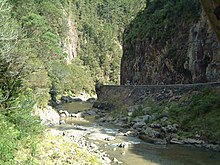
The Kaimai Range is a mountain range in the North Island of New Zealand. It is part of a series of ranges, with the Coromandel Range to the north and the Mamaku Ranges to the south. The Kaimai Range separates the Waikato in the west from the Bay of Plenty in the east.

Waihi is a town in Hauraki District in the North Island of New Zealand, especially notable for its history as a gold mine town.
Paeroa is a town in the Hauraki District of the Waikato Region in the North Island of New Zealand. Located at the base of the Coromandel Peninsula, it is close to the junction of the Waihou River and Ohinemuri River, and is approximately 20 kilometres south of the Firth of Thames.

Hauraki District is a territorial authority within the Hauraki region of New Zealand. The seat of the council is at Paeroa.

Western Bay of Plenty District is a territorial district within the Bay of Plenty Region of New Zealand. The district envelops Tauranga City by land, and includes Matakana Island, at the entrance to Tauranga Harbour.

Waihi Beach is a coastal town at the western end of the Bay of Plenty in New Zealand's North Island. It lies 10 kilometres to the east of the town of Waihi, at the foot of the Coromandel Peninsula. The main beach is 10 kilometres long. The town had a permanent population of 2,760 as of June 2022.

The Coromandel Range is a volcanic mountain range in the Coromandel Volcanic Zone running the length of the Coromandel Peninsula in the North Island of New Zealand. It is located 60 kilometres (37 mi) east of the city of Auckland, and runs north–south for approximately 110 kilometres. It is at a right angle to the Tararua ranges. The highest point in the range is Mount Moehau, at the northern end of the peninsula within the Moehau Range. There are numerous peaks over 600 metres in height. In pre-European times, the southern Coromandel Range was densely forested by trees such as kauri, mataī and tawa, and was a home for birds such as kererū, tui, kākā and kiwi. Greywacke from the ranges was a source for many stone tools used by Hauraki Māori.
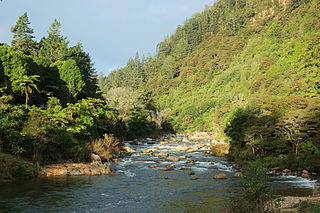
The Ohinemuri River is located in the northern half of New Zealand's North Island, at the base of the Coromandel Peninsula.

Waikino is a small settlement at the eastern end of a gorge in the North Island of New Zealand alongside the Ohinemuri River, between Waihi and the Karangahake Gorge. The Waikino district lies at the base of the ecologically sensitive Coromandel Peninsula with its subtropical rainforests, steep ravines and fast moving rivers and streams. The cascades of the Owharoa Falls lie just to the south west of the settlement.

Waikino Music Festival was a 1977 music and alternatives event held on Bicknell's farm in the Waitawheta Valley between Waikino and Waihi, New Zealand. Between band set ups; solo artists, poets and storytellers, comedians, yoga demonstrations and ravers would entertain, enabling the show to continue without breaks. These ideas were even further developed at the subsequent Nambassa festivals.

The East Coast Main Trunk (ECMT) is a railway line in the North Island of New Zealand, originally running between Hamilton and Taneatua via Tauranga, connecting the Waikato with the Bay of Plenty. The ECMT now runs between Hamilton and Kawerau, with a branch line to Taneatua from the junction at Hawkens. The line is built to narrow gauge of 1,067 mm, the uniform gauge in New Zealand. It was known as the East Coast Main Trunk Railway until 2011, when the word "Railway" was dropped.

The Goldfields Railway is a heritage railway that operates between Waihi and Waikino in the Bay of Plenty region of New Zealand's North Island. It operates over a section of track that was part of the East Coast Main Trunk Railway until the Kaimai Tunnel deviation made it redundant in 1978. The Goldfields Railway was formed in 1980 as the Goldfields Steam Train Society to retain a portion of the old mainline and switched to its current name in the mid-nineties.

The Thames Branch railway line connected Thames, New Zealand, with Hamilton and was originally part of the East Coast Main Trunk railway. Part of the line between Morrinsville and Waitoa remains open and is in use as the Waitoa Branch line, connecting to the Fonterra Dairy Factory at Waitoa.
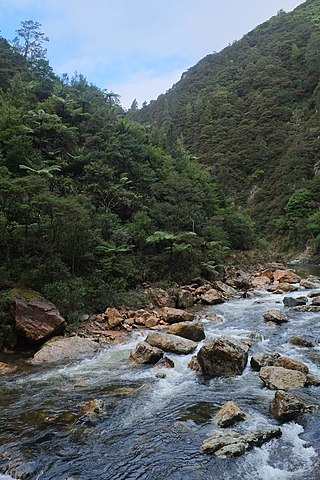
The Waitawheta River is a river of the Waikato Region of New Zealand's North Island. It flows from a point south-east of Mount Te Aroha in the Kaimai Range to the Karangahake Gorge at the foot of the Coromandel Peninsula to reach the Ohinemuri River at Karangahake, five kilometres east of Paeroa.
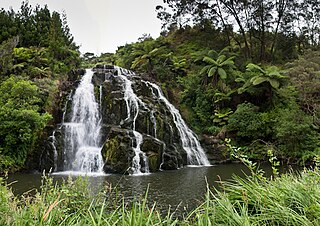
Owharoa Falls is a staircase waterfall in Waikato, New Zealand, located off Waitawheta Road in Karangahake Gorge, near State Highway 2, between Paeroa and Waihi, and close to the small settlement of Waikino.

The Hauraki Rail Trail is one of the Great Rides of the New Zealand Cycle Trail system, using parts of the abandoned ECMT and Thames Branch railways in the Hauraki Gulf plains and the Coromandel Peninsula.
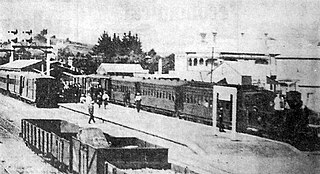
Paeroa railway station is a former railway station in Paeroa; on the Thames Branch, and on the East Coast Main Trunk Railway to Waihi. Between 1895 and 1991 Paeroa had a station at the north end of the town centre, followed by one further north, another back near the town centre and then another over a mile south of the town.

The Waihi-Waikino Gold Tramway was a narrow-gauge railway which ran between gold mines at Waihi and the Victoria Battery at Waikino. Owned by the Waihi Gold Mining Company, it operated from 1897 to 1952. It was the only private railway in New Zealand used by the gold industry.

Kauaeranga Valley is a valley created by the Kauaeranga River, which flows from the Coromandel Range southwest to the Firth of Thames at Thames, New Zealand in the North Island. It contains the settlement of Kauaeranga on the Coromandel Peninsula. It is located near Thames, in the Thames-Coromandel District in the Waikato region. It covers a land area of 180.51 km2.
Mackaytown is a settlement in the Hauraki District and Waikato region of New Zealand's North Island, located at the north-western end of the Karangahake Gorge just south of Paeroa.

